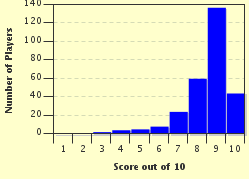Quiz Answer Key and Fun Facts
1. Which of the following chemical symbols is used for potassium?
2. What element, also known as quicksilver, was named after the Roman messenger of the gods?
3. Which element did Marie Curie discover and name in 1898?
4. Which of the following is NOT an element named after a planet?
5. What is the first element to be named after an institution of higher learning?
6. More than 30 elements play a key role in plant and animal life, but which of the following elements accounts "for two to three pounds of our total body weight" and helps build strong teeth and bones?
7. Can you tell me, in addition to chlorine, what other element is in common table salt?
8. What is the chemical element which is contained in virtually all molecules of the body (excluding water)?
9. Which metal has the highest melting point?
10. A little off the topic, can you name the 17th James Bond film, which refers to a group 11 element with an atomic number of 79?
Source: Author
nyirene330
This quiz was reviewed by FunTrivia editor
CellarDoor before going online.
Any errors found in FunTrivia content are routinely corrected through our feedback system.


